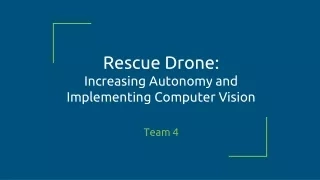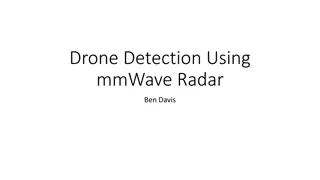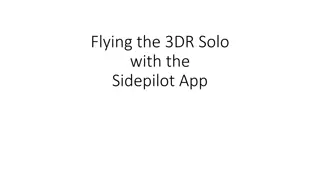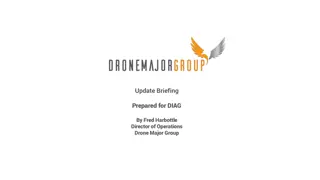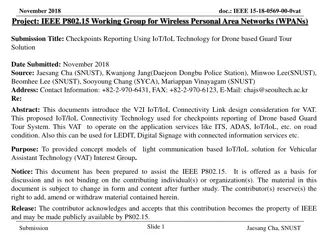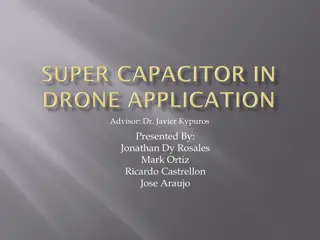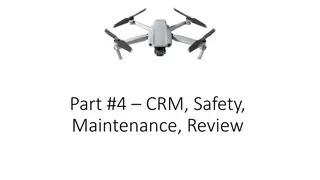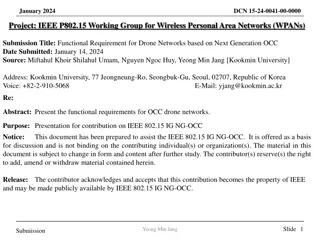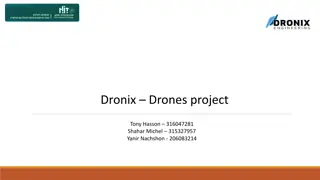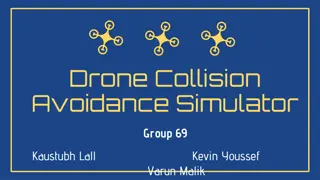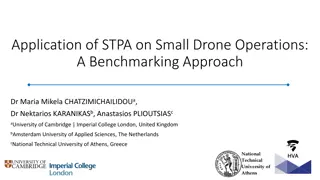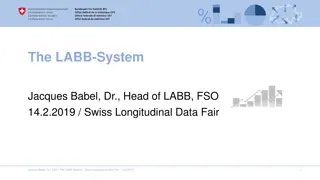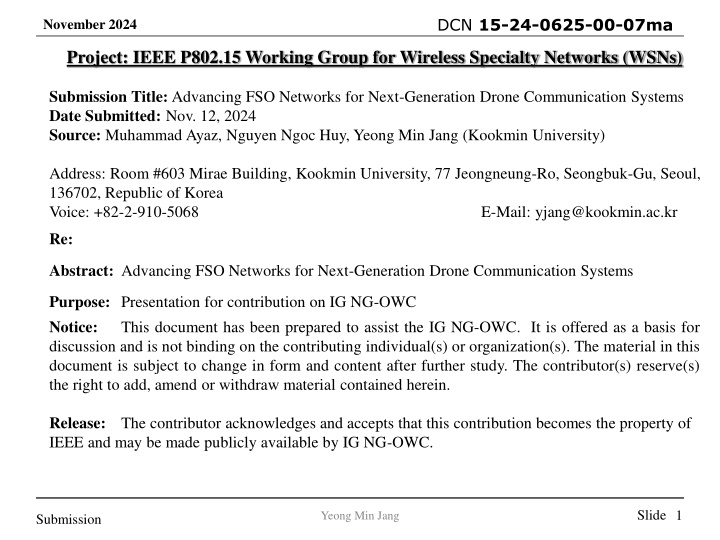
Advancing FSO Networks for Next-Gen Drone Communication Systems
Explore the potential of Free Space Optics (FSO) integrated with drones for high-speed, secure communication networks. Discover how this technology can revolutionize various applications and leverage Named Data Networking (NDN) for enhanced efficiency and performance.
Download Presentation

Please find below an Image/Link to download the presentation.
The content on the website is provided AS IS for your information and personal use only. It may not be sold, licensed, or shared on other websites without obtaining consent from the author. If you encounter any issues during the download, it is possible that the publisher has removed the file from their server.
You are allowed to download the files provided on this website for personal or commercial use, subject to the condition that they are used lawfully. All files are the property of their respective owners.
The content on the website is provided AS IS for your information and personal use only. It may not be sold, licensed, or shared on other websites without obtaining consent from the author.
E N D
Presentation Transcript
DCN 15-24-0625-00-07ma November 2024 Project: IEEE P802.15 Working Group for Wireless Specialty Networks (WSNs) Submission Title: Advancing FSO Networks for Next-Generation Drone Communication Systems Date Submitted: Nov. 12, 2024 Source: Muhammad Ayaz, Nguyen Ngoc Huy, Yeong Min Jang (Kookmin University) Address: Room #603 Mirae Building, Kookmin University, 77 Jeongneung-Ro, Seongbuk-Gu, Seoul, 136702, Republic of Korea Voice: +82-2-910-5068 E-Mail: yjang@kookmin.ac.kr Re: Abstract: Advancing FSO Networks for Next-Generation Drone Communication Systems Purpose: Presentation for contribution on IG NG-OWC Notice: This document has been prepared to assist the IG NG-OWC. It is offered as a basis for discussion and is not binding on the contributing individual(s) or organization(s). The material in this document is subject to change in form and content after further study. The contributor(s) reserve(s) the right to add, amend or withdraw material contained herein. Release: The contributor acknowledges and accepts that this contribution becomes the property of IEEE and may be made publicly available by IG NG-OWC. Slide 1 Yeong Min Jang Submission
DCN 15-24-0625-00-07ma November 2024 Advancing FSO Networks for Next- Generation Drone Communication Systems Nov. 12, 2024 Slide 2 Yeong Min Jang Submission
DCN 15-24-0625-00-07ma November 2024 Contents Backgroud UAV-FSO communication deployment FSO-based drone-assisted mobile network architecture Proposed System Model Conclusion References Slide 3 Yeong Min Jang Submission
DCN 15-24-0625-00-07ma November 2024 Background Free Space Optics (FSO), a wireless optical communication technology, presents a promising solution for high-speed, secure, and flexible communication networks. When integrated with Unmanned Aerial Vehicles (UAVs), or drones, FSO can revolutionize various applications, from emergency response and disaster relief to precision agriculture and remote sensing. Named Data Networking (NDN) is a revolutionary network architecture that leverages a content-centric approach, significantly enhancing network performance and efficiency NDN's in-network caching mechanism enables data to be cached at various network nodes. This reduces network congestion and latency, especially in scenarios where multiple drones require the same data. Slide 4 Yeong Min Jang Submission
DCN 15-24-0625-00-07ma November 2024 A typical UAV-FSO communication deployment scenario. A combination of UAV-FSO can provide seamless connectivity with high-speed data and secured transmission A typical UAV-FSO deployment scenario with a wide range of applications i.e., inter UAV-FSO communication between UAVs for range enhancement, disaster management, last-mile access, communication, The integration of communication with cutting-edge advances in 5G and future 6G technology promises revolutionary potential.[1] satellite-to-ground UAV-based FSO Fig.1: UAV-FSO Communication Slide 5 Yeong Min Jang Submission
DCN 15-24-0625-00-07ma November 2024 FSO-based drone-assisted mobile network architecture. Fig.2: FSO-based drone-assisted mobile network architecture.[3] Slide 6 Yeong Min Jang Submission
DCN 15-24-0625-00-07ma November 2024 System Model Drone-based networking services may require frequent handovers due to their shorter coverage radius compared to traditional infrastructure like cellular networks. As a result, it handles frequent handovers by pre-caching data to the target network provider before handover via a content store. The operation process occurs when a drone receives an Interest packet. First, when it receives an interest of data, it determines if data exists in its CS. If data exists, it decides if it should be pre-cached. Generates an Interest Packet (Request for Data) Send Interest Packet (Request for Data) Data Packet Response Returning the Data Packet Slide 7 Yeong Min Jang Submission
DCN 15-24-0625-00-07ma November 2024 Advantages Reduced Latency Once the alert data is cached in the network, other drones can receive the same information quickly, without waiting for it to be generated or fetched from the original source again. Efficient Resource Usage Caching reduces the need for repeated requests to the same source, which is especially useful in a highly mobile and dynamic environment like vehicular networks, where vehicles are constantly moving and changing locations. Built-in Security The Data packets are signed by the data producer (Vehicle A). This ensures that the alert message came from a legitimate source and hasn t been tampered with, which is crucial for safety-critical applications in vehicular networks Scalability As more vehicles on the road request data, the network can scale effectively. The data is distributed across the network through caching and interest forwarding, allowing the system to handle a large number of vehicles without overwhelming central servers Slide 8 Yeong Min Jang Submission
DCN 15-24-0625-00-07ma November 2024 Conclusion The integration of Named Data Networking (NDN) and Free Space Optics (FSO) presents a promising avenue for the development of advanced drone networks NDN content-centric approach and in-network caching capabilities offer significant advantages in terms of scalability, flexibility, and resilience, particularly in dynamic and unpredictable drone environments FSO provides high-speed communication links with minimal electromagnetic interference, making it ideal for drone-to-drone or drone-to-ground communication in environments where traditional RF-based communication might suffer from congestion or interference By leveraging FSO's high-speed, secure, and license-free communication, we can further enhance the performance and reliability of drone networks. Slide 9 Yeong Min Jang Submission
DCN 15-24-0625-00-07ma November 2024 References [1] Nzekwu, N. J., Fernandes, M. A., Fernandes, G. M., Monteiro, P. P., & Guiomar, F. P. (2024). A comprehensive review of UAV-Assisted FSO relay systems. Photonics, 11(3), 274. https://doi.org/10.3390/photonics11030274 [2] Choi, S., Joe, I., & Kim, W. (2019). Data Pre-Caching Mechanism in NDN-based Drone Networks. Journal of IKEEE, 23(4), 1116 1121. https://doi.org/10.7471/ikeee.2019.23.4.1116 [3] Yu, L., Sun, X., Shao, S., Chen, Y., & Albelaihi, R. (2023). Backhaul-Aware Drone Base Station Placement and Resource Management for FSO-Based Drone-Assisted Mobile Networks. IEEE Transactions on Network Science https://doi.org/10.1109/tnse.2022.3233004 [4] Gu, Z., Jiang, J., Dong, T., Liu, Z., & Ji, Y. (2024). Cross-Layer Topology Control Mechanism for FSO-Based UAV Relay https://doi.org/10.1109/iccworkshops59551.2024.10615902 and Engineering, 10(3), 1659 1668. Networks. MDPI, 1274 1279. Slide10 Yeong Min Jang Submission

